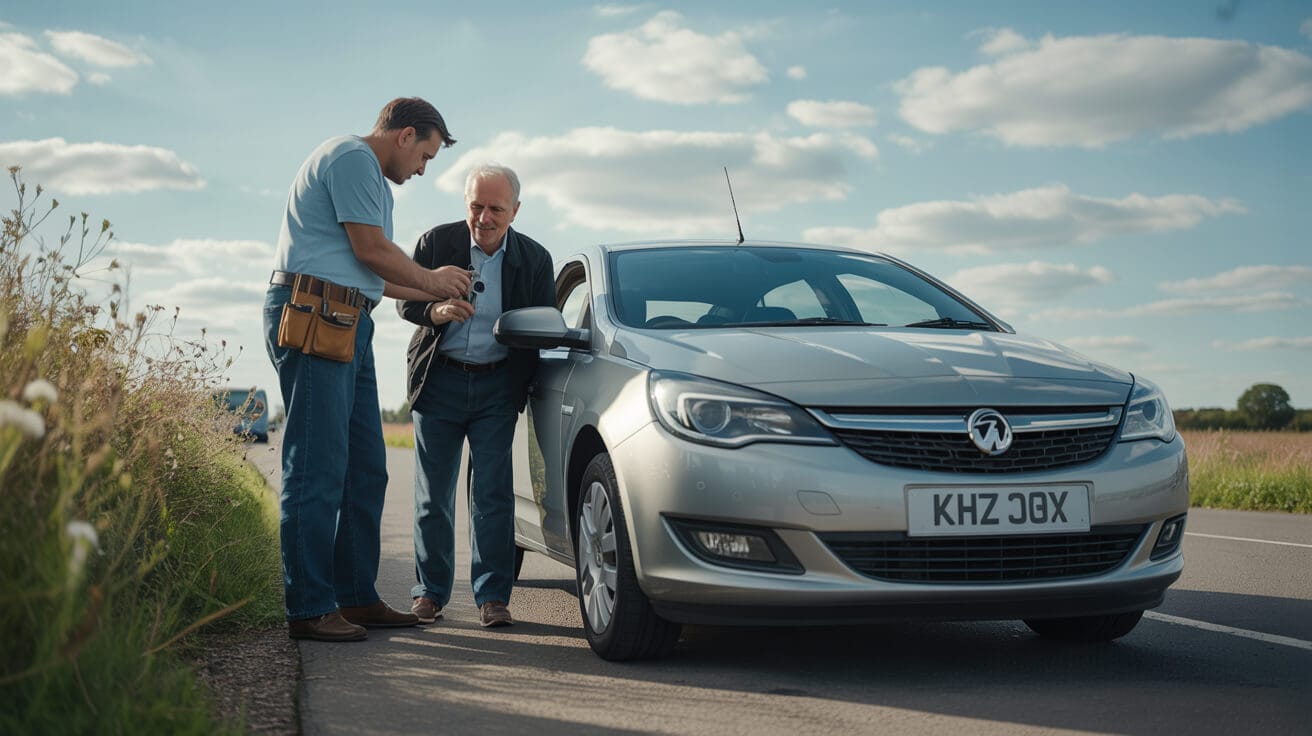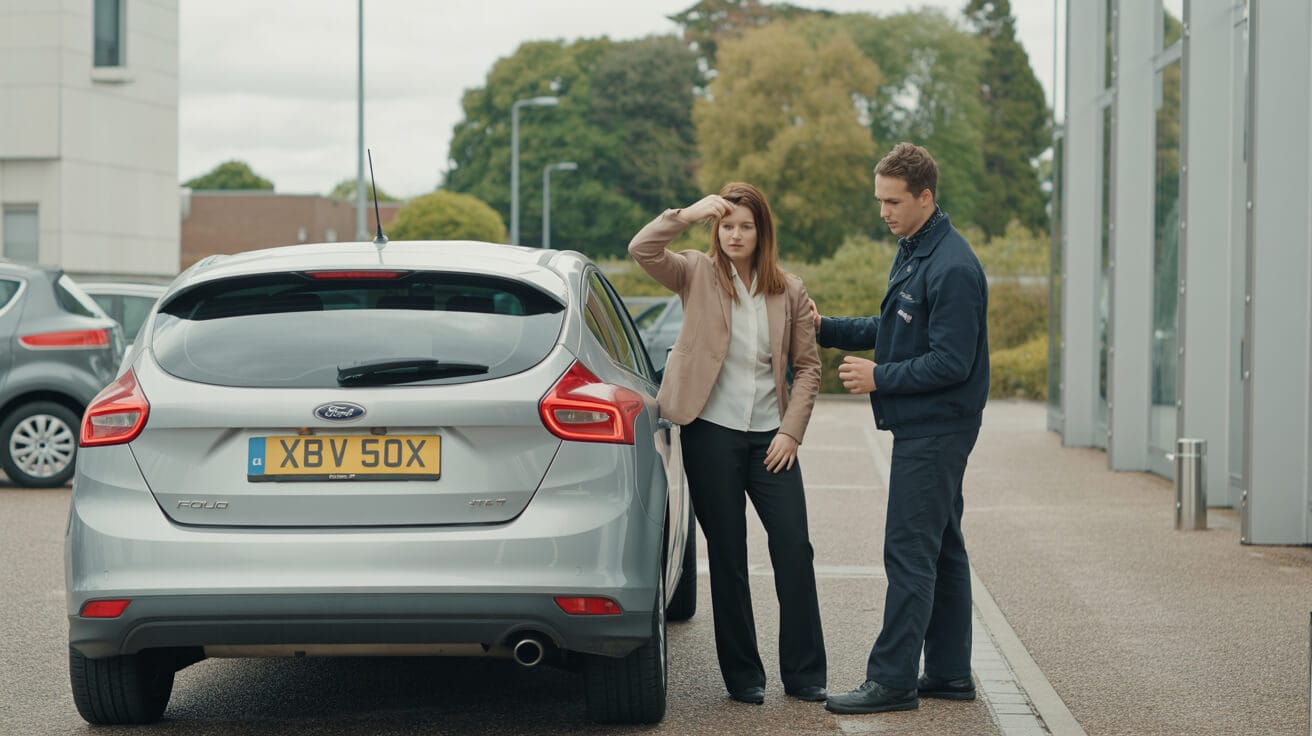Why Does My Steering Wheel Lock Up and the Key Won’t Turn—Is This Actually a Fault or Is It Built In?
A steering wheel that suddenly locks solid, paired with a key that just won’t turn, feels like your car letting you down—but in most cases, this “failure” is actually by design. Modern vehicles, especially across the UK and Europe, are engineered with security layers that protect both the car and your investment: a mechanical steering lock, an electronic immobiliser, and intelligent control modules all working together. Parked wheels under tension, a slightly worn key, or a tired remote battery will often trigger these features, keeping thieves out but sometimes catching you in the net too.
In most cases, the issue is about system sequence, not a breakdown. Leaving wheels sharply turned, relying on an old key copy, or parking with a failing key fob battery can trigger a protective lockout. The right thinking—pause, assess, act methodically—transforms this moment from crisis to a simple reset.
H3: The Real Triggers—Not Just “Bad Luck”
- Parking pressure: – Steering wheels jammed hard against kerbs tighten the locking bolt, setting up the “stuck key” effect.
- Key wear and misalignment: – A physically worn key or cylinder prevents the pins and tumblers from aligning as engineered.
- Electronic steering lock hiccups: – Faulty modules or low battery voltage can leave electronic steering locks (ESL) in the “on” position.
- Immobiliser handshake misses: – If your fob’s signal is weak or out of sequence, the immobiliser disables the starter.
- Remote key battery fail: – Even a fob that worked yesterday can drop voltage fast, especially in cold weather.
All modern cars—yes, including push-to-start models—layer mechanical and electronic elements, so problems often have more than one cause.
H3: How to Read the Car’s Clues
- Complete wheel lock: – The wheel refuses to move in any direction. This is usually mechanical.
- Key dead-stuck: – Can’t turn at all? Suspect alignment or an electronic lock failing to release.
- Dashboard messages like “Key Not Detected” or “Steering Lock Engaged”: – Now you’re looking at an electronic issue, not just a physical one.
- Silent key with a “click” or no crank: – Tells you the immobiliser hasn’t given permission.
- A pattern of soft clicks: – Sometimes means the system is trying, but not succeeding.
A gentle, stepwise approach gets better results than forcing the key—calm heads save panels, columns, and wallets.
Should You Try to Fix a Locked Steering Wheel Yourself—Or Can That Backfire Fast?

Getting your steering unlocked and the key turning again feels urgent, especially if you rely on your car every day. But the difference between a quick fix and a lasting one comes down to method—rushing or “brute force” can multiply costs or permanently damage the car. UK insurance and warranty policies frequently exclude damage caused by “owner interference,” so patience and compliance matter.
The rule of thumb: safe, non-destructive checks are fine, but if anything feels wrong, stop. Top professionals like Autolocks Ltd always start with permission, ID checks, and scene safety for good reason. Adopting that mindset (even at home) protects both your car and your rights.
H3: Fast Isn’t Always Smart—Why Patience Pays in Steering Lockouts
People get in trouble when they try to “force” a solution. Modern locks require gentle touch, smart observation, and respect for each system’s limits. Acting out of frustration (or watching generic online videos) can break precision components or trigger anti-theft modules—mistakes that only show up as bigger, costlier fixes down the line.
H3: Action Steps—The Right Way to Troubleshoot Without Breaking the Bank
- Gently move the wheel while easing the key – Never force or twist hard.
- Check your key and remote for obvious damage or battery weakness – Even tiny wear can matter.
- For keyless cars, tap the fob directly onto the start button – This helps bypass weak wireless signals.
- Replace the key fob’s battery immediately if you’ve never done so – Even a “good” battery can drop below threshold fast.
- Watch the dashboard for clues – Messages or icons will direct next steps.
H3: Biggest DIY Mistakes (And What to Avoid)
- Forcing the key or wheel past resistance—this breaks keys or damages pins.
- Hammering or “tapping” the lock to loosen it—modern columns can’t take the abuse.
- Dousing with spray lube—causes corrosion or softens plastic parts.
If in doubt, call a specialist early. Their protocols mirror factory and insurance practices—protecting both your car’s value and your evidence trail.
What’s Really Happening When Key, Steering Lock, and Immobiliser All Refuse to Cooperate?

Every ignition—whether old-school key or modern proximity fob—triggers a complex security dance before you can drive. In a UK car, that means a mechanical lock releases, a digital chip authenticates your key or fob, and a control unit gives the final start command—all within milliseconds. Miss a step, and you’re going nowhere.
The system’s sophistication is its strength (to block car thieves) and sometimes its weakness (inconveniencing you). Age, interference, battery sag, and even module software glitches can disrupt the chain. Your key becomes three things at once: physical unlocker, digital transmitter, and handshake initiator for cryptographic startup.
H3: Don’t Just Blame the Steering Lock—Most Faults Lie Elsewhere
Most people think the wheel is to blame, but problems often arise upstream. A marginal fob battery, for instance, can completely disconnect immobiliser handshake, making even a perfect lock seem broken. A single “Steering Lock Malfunction” light or a stuttering immobiliser icon on your dash means it’s time to think beyond the cylinder.
H3: Table—Diagnosing the Root Cause: Mechanical, Digital, or Network?
Before you try any solution, check for these difference-makers:
| Mechanical Issue | Digital/Electronic Issue | Network/System Issue | |
|---|---|---|---|
| **Symptoms** | Key tangles, wheel fully stuck | Error messages on dash (“No Key”) | Issues change after swapping batteries |
| **DIY Risk** | Key/cylinder damage if forced | Can trip anti-theft, brick electronics | High – modules or data can misalign |
| **Fix Scope** | Needs professional key repair/cut | Needs diagnostics, battery/fob swap | Needs factory-level scan/coding |
Most lockouts look simple—but systems often cross over, making one size fits all fixes risky.
H3: Dashboard and Sound Cues—Your Fastest Win
Listen for soft clicks (column), silence (immobiliser), or network warning lights. Take photos of any dashboard messages—they’re worth their weight in gold when talking to a mobility specialist.
Why Do So Many Owners Make Things Worse—And What’s the Step-By-Step to Actually Solve a Locked Steering Wheel or Key?

Jumping straight to force is where most car owners go wrong. They miss the clues their vehicle is quietly delivering—stiffness, faint clicks, error icons—each a pointer to a safe fix. Modern ignition and lock systems demand patience, not muscle.
Unlocking or recovering from a lockout is a sequenced process: each action should increase safety, not risk. This method pays off with lower costs, less damage, and more time on the road.
H3: Common Mistake—Ignoring Warning Signs and “Upgrading” to Aggression
It’s easy to blame a bad day, a badly-cut key, or “bad luck.” But rushing through, skipping clues, and escalating with tools or sprays quickly turns a £10 issue into a £400 column rebuild. Cars try to tell you what’s wrong; listen for dashboard hints, keys that half-rotate, or fobs that seem “lazy”—they’ll save you downtime and expense.
H3: Pro-Approved Sequence—From Gentle to Professional, Step by Step
- Relieve any tension in the steering column by gently moving the wheel as you try the key.
- Inspect your key and key fob for wear, bends, or battery issues—swap with your spare if it’s handy.
- Centre the wheel—locked steering can put the system under extra stress.
- Check for error lights and note any messages.
- If keyless, touch your fob to the marked column spot or start button—the signal may be weak.
If nothing prompts a fix, or if new symptoms arise, stop and document everything. Each detail improves outcome and reduces cost if you need professional input.
Can You Prevent Steering Lockouts—or Are Stuck Wheels and Keys Just the Price of Modern Cars?

Most steering lockouts aren’t some unavoidable fluke—they’re the compound result of skipped maintenance, small oversights, and assumptions about “smart” technology doing all the work. The cost of assuming your car is immune is lost time, money, and preventable stress.
Regular, routine habits keep locks, keys, and immobilisers working at their best. Waiting for issues to become urgent always increases cost—owners who stay proactive rarely face sudden breakdowns.
H3: Myths to Drop—A New Car Can Still Get Stuck
A “smart” car, a new key, or a recent dealer service does not offer immunity. Batteries wear, keys bend, and columns accumulate microscopic dust—no vehicle is invincible, and prevention is always cheaper than cure.
H3: Table—Preventive Actions That Work for Every Vehicle
Simple routines can extend your steering and key system’s lifespan significantly:
| Routine | Why It Helps | How Often |
|---|---|---|
| Straighten wheels | Minimises lock pin tension | Every trip |
| Alternate keys/fobs | Spreads wear, reveals issues early | Monthly |
| Swap fob battery | Removes “invisible” faults | Quarterly |
| Regular visual check | Catches wear and misalignment | Annually |
| Professional checkup | Finds hidden electronic decay | Annually |
Proactive owners save hundreds on avoidable repairs. Add one new habit each month—you’ll be surprised how much money and stress you avoid.
- Park with wheels straight
- Rotate which key or fob you use
- Add fob battery changes to your calendar
- Respond early to slow dashboard “wake up”
Structured habits keep you and your car on the best footing.
When Does DIY Cross Into Risky Territory—And When Should You Call a Steering Lockout Specialist?

Knowing where to stop is as important as knowing what to try. Risks increase sharply with modern systems—especially after 2015, where electronic locks, smart keys, and complex ECUs escalate even minor mistakes into expensive failures. Manufacturer warranties and some UK insurance policies strictly define “owner interference” as a reason to deny claims. Strategic intervention, not pride, protects both you and your car.
H3: Red Flags—End DIY if You Notice These
- Key turns but the immobiliser icon stays on
- The wheel feels grittier, not just tight
- New fob battery does not resolve “no key” or “steering lock” errors
- Any trim or switch is damaged during troubleshooting
H3: Professional “Musts”—When Compliance and Auditability Are Essential
- Warning lights related to steering, immobiliser, or security persist
- 2016+ cars with push-to-start or smart access fail to reset after checks
- Prior repair attempts have already failed or left damage
- You need documentation for warranty, lease, or resale
Professionals like Autolocks Ltd bring compliance, audit trails, and insurance-grade documentation. The value isn’t just in a quick fix—but in safeguarding the future.
H3: The “Baton Pass”—When Strategically Escalating Saves Headaches
Knowing when to seek help is a mark of skill, not surrender. Stepping away prevents compounding errors, ensures warranty health, and creates a clear audit trail if things progress to a claim or dealership visit.
What Value Does a Professional Steering Lockout Service Provide—And Why Pick an Auto Locksmith Over a DIY or Generic Garage?

A professional lockout specialist offers more than just a fix—they deliver assurance, compliance, and longevity for your car. Industry pros like Autolocks Ltd start each job by confirming your identity, consent, and safety. They follow strict, stepwise protocols: non-destructive entry, key and system diagnostics, privacy-guarded records, and full compliance to ISO and auto-industry standards.
Whereas a DIY solution may “work now” but cost more in the long run, and a general garage may not have the security clearance or the tools to operate at full protocol. An expert gives you a fix plus legal cover, warranty proof, and full aftercare.
H3: Table—What Sets Pro Service Apart
| Autolocks Ltd (Pro) | DIY Attempt | General Garage | |
|---|---|---|---|
| ID & consent | Always checked | Never | Sometimes |
| Non-destructive-first | Yes | No | Not guaranteed |
| Digital diagnostics | Dealer-level systems | No | Varies |
| Evidence/audit logs | Full record/secure | No | Sometimes |
| Warranty/aftercare | Guaranteed | None | Variable |
| Compliance/standards | ISO-aligned | Never | Unclear |
H3: Why Choosing a Specialist Protects Your Interests
- Every action is logged, protecting your rights at every step
- Full compliance strengthens resale, warranty, and insurance options
- Technicians use up-to-date methods that reduce risk to vehicle trim, electronics, and future value
Focusing on compliance is not bureaucracy for its own sake—it’s the foundation that makes every fix legitimate and bulletproof.
How Do Professional Auto Locksmiths Tackle Locked Steering Wheels and Keys—And Why Is Their Diagnostic Process Superior?

Professional lockout services don’t just rely on “feel.” They use protocols, digital tools, and documentation models honed for the modern UK market. Licenced specialists from firms like Autolocks Ltd deploy a seven-step, audit-trail-enabled process—delivering not just a fix but evidence to protect your insurance, warranty, and resale value.
H3: Industry-Certified Diagnostic Steps
- Confirm owner ID and consent—recorded for compliance.
- Begin with a full, non-destructive mechanical check—no rash tools.
- Audit key and remote: test battery under load, interrogate chip, check signal and programming data.
- Scan for faults using OEM-approved or dealer-grade tools: module, immobiliser, and steering lock errors are mapped and logged.
- Reprogram, refurbish, or replace as needed—module adaptation, coding, or new keys are all performed under manufacturer-aligned protocol.
- Document every step: time, tech, tool, and outcome stored in encrypted records.
- Complete the job with a post-fix demonstration, “paper” handover, and warranty/aftercare brief.
H3: Each Step Serves You—Short and Long Term
Every element in the protocol is weighted for value: minimal damage, legal protection, forward traceability, and compliance with modern car software and insurance frameworks.
Failing to follow a system risks the issue returning—or losing insurance/warranty claims down the line. Choosing full-process professionals is an investment in the future.
Can Even Costly Steering Lock or Key Faults Be Fixed Without Breaking Your Warranty or Paying Dealer Prices?
Many lockouts, stuck keys, and steering lock electronic errors can now be resolved on your driveway—without forcing you to pay main dealer rates or wait days for a fix. The caveat: only choose a provider with ISO-aligned compliance, digital audit trails, and experience matching both legacy and advanced auto systems. When you do, your repair record bolsters warranty, resale, and insurance standing.
It’s time to drop the idea that “only the dealer” can sort modern steering or key-related faults. Properly equipped specialists—with the right credentials—can deliver better outcomes at lower costs, with all the proof you need for compliance.
H3: The False Economy of “Quick Fixes”
Short-term hacks—skipping logs, using generic parts, or ignoring compliance—almost always add future headaches. Professional-grade, logged repairs save you from ripple-costs: warranty risk, failed MOTs, and future module damage. Investing once is often less expensive (and more reliable) than cutting corners now.
H3: Table—Dealer, Pro, or DIY: What Do You Really Get?
| Service Type | Autolocks Ltd Pro | Dealer | DIY/Home Fix |
|---|---|---|---|
| Transparent pricing | Yes | Itemised, costly | Hidden or escalating |
| Warranty preserved | Yes | Yes | Rarely |
| On-site convenience | Yes | No (car travels) | No |
| Compliance & privacy | Yes, ISO/logged | Varies | No |
| Speed of service | Hours–same-day | Days–weeks | Variable |
If you hire a professional, expect their process and audit trail to be as robust as any main dealer’s—often with less hassle and more convenience.
Don’t let short-term thinking cost you more—let compliance and expertise protect your bottom line.
When Steering Wheel Lockouts Become a Test of Ownership, Why Is Autolocks Ltd the Right Choice Every Time?
A steering lock crisis isn’t just a test of patience—it’s a moment that can define your vehicle’s future value, your insurance standing, and your peace of mind. All too often, the way you solve the problem matters just as much as getting moving again.
Autolocks Ltd brings more than a fix—each intervention is a shield for your investment. With every job, you receive an evidence-backed, compliance-driven repair: full ID verification, carefully documented diagnostics, strict non-destructive techniques, and audit-logged programming. Our team’s process is engineered to give you not just a functioning car, but a data trail powerful enough to protect against disputed warranties, future breakdowns, or resale doubts.
H3: Unlock Long-Term Value With Every Solve
- Every job is handled with ISO and insurance compliance as a baseline, not an upgrade
- Every detail from consent to aftercare is recorded and encrypted—no step skipped
- You keep control: transparent choices, predictable pricing, and ready aftercare for any new question
Your trust is earned not only with fixing today’s problem, but with the paperwork, transparency, and warranty evidence that ride with every intervention.
Choose Autolocks Ltd when you want every part of the experience—identity verification, stepwise diagnostics, key coding, and post-fix care—delivered with the rigour of a main dealer, but faster, on your terms, and with full transparency. If you value lasting warranty health, flawless service records, and true privacy for your car, we’re always ready to assist you, wherever you are.
Frequently Asked Questions
Why does my car’s steering wheel lock and the key won’t turn?
A locked steering wheel and stuck key mean your car’s anti-theft system is working as intended—it’s a safety reflex, not a sudden failure. After switching off, the wheel locks to stop theft, only unlocking when the key is inserted and conditions are right. UK data shows these systems trip more often in damp or cold weather, with breakdown calls peaking after frosty mornings. For owners, it can feel like a design flaw—especially with unclear dashboard signals or if tension builds in traffic or a tight parking spot.
The smallest misstep here can derail your day—prevention beats panic every time.
If you hear a soft click after removing the key or notice a yellow steering lock symbol, don’t force anything. Pause and try this: turn the wheel gently in both directions while applying steady, light pressure to the key. For push-button or app-based systems, make sure your fob is close (and awake). Most cases resolve on the spot, without tools or panic. Deeper lockouts linked to battery or wiring issues need professional diagnosis. Find a full guide at Autolocks Ltd (https://www.autolocksltd.com/) and view breakdown trends at the RAC (https://www.rac.co.uk/drive/advice/car-maintenance/what-to-do-if-your-steering-wheel-is-locked/). If you’re still immobilised, expert help is ready.
How the system works
- Lock engages after key removed
- Unlocks only with correct key/fob sequence
- Sensitive to environmental factors
When to worry
If the wheel stays locked after the standard reset or repeated key/fob attempts, the cause may run deeper—battery, electronics, or cylinder issues could be at play.
Which home fixes do more harm than good when the key or steering wheel get stuck?
Forcing the key, tapping the wheel, or squirting household sprays into the lock are the quickest ways to leave yourself with a bigger repair bill. Modern ignition barrels are built to tight tolerances; brute force can bend wafers or break the key, while DIY sprays gum up sensitive electronics and leave oily residues that trap dirt and moisture. Insurer and manufacturer guidance now explicitly warns against these tactics, citing increased warranty denials and component failures.
Shortcuts that promise instant fixes tend to trade seconds for days lost—every forced attempt leaves a mark.
Rapid-fire attempts to unlock or start—especially with digital keys or remotes—can trigger anti-tamper mode. After only a few failed attempts, many immobiliser systems will fully lock down, requiring dealer-level resets you can’t do at home. Surveys by Which? show a third of non-start recoveries are due to battery or electrical issues, not a stuck lock (https://www.which.co.uk/reviews/new-and-used-cars/article/car-lock-and-security-issues-aDZER9N9iVUS).
Before acting, check official advice and use Autolocks Ltd’s secure troubleshooting resource (https://www.autolocksltd.com/) to avoid escalating to an unfixable scenario.
Costly errors to avoid
- Applying physical force to key or wheel
- Using unapproved sprays or lubricants
- Repeated failed unlock/start cycles with remotes
Safer mindset
If you’re unsure, limit repetition and avoid “just one more try.” Low or dead batteries, misaligned keys, and wiring faults are usually the actual culprits—leave diagnosis to a pro when basic resets don’t work.
How can you tell if your lockout is mechanical, electronic, or a security fault?
Identifying the right cause is the game-changer—getting it wrong adds time, cost, and stress. A worn or bent key, particularly common in older cars, usually points to a mechanical fault in the ignition barrel. In newer vehicles, flat battery (fob or main), faulty sensors, or module wiring issues are much more likely. Spotting which is which means looking for clues—not all stuck keys are the same.
| Symptom | Likely Fault | Quickest Test |
|---|---|---|
| Key sticks; visible wear | Mechanical/Barrel | Try spare or new-cut key |
| “Lock” warning lights/beeps | Electronic/Immo | Scan for DTCs/code errors |
| “Key not detected” message | Security/Battery | Replace fob battery |
| Digital/app key unresponsive | Security/Software | Reset app/Bluetooth/NFC |
The modern car guards itself on ten fronts—your best move is observing what happens just before things lock up.
Look for clear patterns: if it happens after rapid wheel movement or you parked at an odd angle, mechanical force may be at fault. If warnings or messages flash on the dash, chances are electronics or security networks are to blame. Diagnostic tools—like those at Autolocks Ltd (https://www.autolocksltd.com/)—uncover invisible issues missed by standard checks, while sites like WhatCar (https://www.whatcar.com/news/what-to-do-if-your-car-key-is-not-working/n20168) break down advanced troubleshooting steps.
Mechanical vs. Electronic vs. Security
- Mechanical: Physical key damage, stiff barrel, no dash warnings
- Electronic: Warning lights, non-responding remote, power issues
- Security: Repeated wrong key/fob attempts, failed digital authentication, “key not recognised” errors
What safe steps should you try yourself before calling for help?
Start with non-destructive, reversible actions—these never void your warranty or add to the bill. Gently rock the wheel left and right while turning the key; often, that’s enough, especially after parking with wheels at an angle. Next, swap in a fresh battery for your key fob or remote—most are common coin cells (CR2032 or similar), and weak power is behind a significant share of failed starts.
Small changes done right save hours chasing bigger fixes—focus on the basics before ever reaching for a tool.
Never strike or wiggle the key aggressively, and avoid sprays from the toolbox or kitchen—these risk permanent barrel and board damage. If your car uses digital keys or smartphone access, close and relaunch the app, double-check permissions, and ensure all Bluetooth or NFC signals are active. For firm guides and checklists, Autolocks Ltd details every self-check and risk-free reset (https://www.autolocksltd.com/). See also The Car Expert’s risk advisory (https://www.thecarexpert.co.uk/why-not-to-spray-lubricant-into-your-car-ignition/).
Before calling a professional
- Try the gentle wheel-key reset technique
- Replace the fob’s battery; keep the spare handy
- Use only car-specific key lubricants, if any
- Limit troubleshooting attempts to avoid triggering security lockdown
If you’re locked out after a few methodical attempts, or error messages persist, expert support is always the next and best move.
What does a certified auto locksmith do differently—and why does it matter?
A professional locksmith begins where DIY stops: first, by validating you as the car’s true owner (a legal and insurance requirement). They use dealer-grade diagnostic tools to read your car’s network traffic—decoding handshake signals, module status, and encrypted logs invisible to off-the-shelf scanners. By isolating the root cause, they skip guesswork and prevent costly part-swapping.
Great locksmiths work two jobs: solving your problem, and proving every step for your claim or resale.
Every action—and every fix—is non-destructive and audit-trailed: from cutting or programming a new key to resetting immobiliser modules or updating digital permissions, every touchpoint is logged, photographed, and explained. This record isn’t just nice to have: top insurers demand it, and it’s worth its weight in future resale or warranty claims. Autolocks Ltd operates to this gold standard (https://www.autolocksltd.com/), and the Master Locksmiths Association’s consumer guide (https://www.masterlocksmiths.co.uk/steering-wheel-locked-solution) confirms these best practices.
Professional vs. DIY
- Legally secured, identity-verified access
- Diagnostic-first (no blind part swaps)
- Non-destructive, documented repair and handover
- Warranty and claim support built-in
How do professional documentation and standards protect your car’s value and your rights?
Repairs done by certified locksmiths who comply with ISO 26262 and ISO/SAE 21434 don’t just fix the problem—they protect your financial interests and legal standing. Every authorised fix is fully logged, before-and-after photographed, and matched to your vehicle via ownership records. This audit chain secures your warranty, unlocks insurance settlements, and preserves resale value.
In the world of vehicle security, the real key is proof—without it, even perfect repairs won’t shield you from future problems.
Autolocks Ltd writes every quote in plain English, delivers post-job care instructions, and keeps digital records safe for years. The Security Institute reminds owners (https://security-institute.org/compliance-in-the-locksmith-industry/) that lacking verifiable service history blocks everything from warranty payouts to smooth dealership trade-ins.
Insist on certified, documented, and transparent repair—and you’ll never have to defend yourself twice for the same issue.
Why compliance and records are your edge
- Coverage: Unlocks warranty and eases insurance claims
- Value: Proves service for future buyers and dealers
- Defence: Shields against questions of ownership or method
Trust your instincts, but back them with expertise and evidence. If your car won’t budge, Autolocks Ltd has the compliance-first strategies and transparent service every vehicle owner deserves—today, tomorrow, and at resale.







